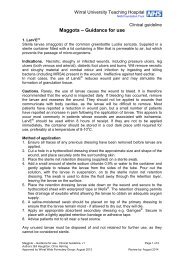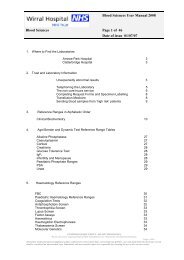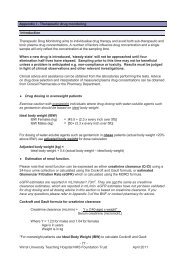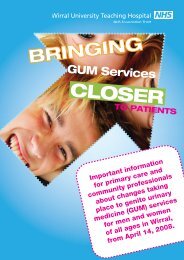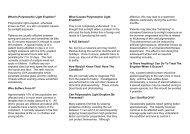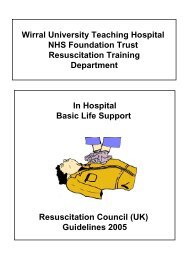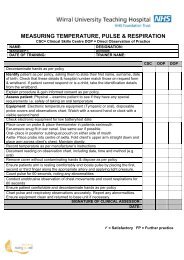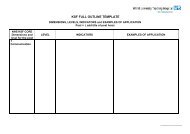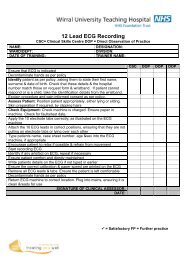Enteral Nutrition Support Nasogastric feeding Tube
Enteral Nutrition Support Nasogastric feeding Tube
Enteral Nutrition Support Nasogastric feeding Tube
- No tags were found...
Create successful ePaper yourself
Turn your PDF publications into a flip-book with our unique Google optimized e-Paper software.
<strong>Enteral</strong> <strong>Nutrition</strong> <strong>Support</strong><strong>Nasogastric</strong> <strong>feeding</strong> <strong>Tube</strong>Angela Kenyon / Amy Corris<strong>Nutrition</strong> <strong>Support</strong> NursesW U T H
• Whenever possible enteral access isthe preferred route• Helps maintain mucosal integrity• Reduces the risk of bacterialcolonisation and translocation(NICE 2006)
Contraindications• Nasal injuries• Base of skull fractures
Post Pyloric Placement• High risk of aspiration• Gastric stasis - motility agent• Upper gastrointestinal stricture
Safe Placement and ManagementThe patient:• Assessment to identify if NG <strong>feeding</strong> isappropriate• clear explanation of the procedure• patients role in supporting placement• gain verbal consent
Safe Placement and ManagementWho should Place?• <strong>Tube</strong>s should be inserted by a healthcareprofessional with the relevant skills and training(NICE 2006/NPSA 2011)• Placement requires skill and competence inorder to minimise risk including the number ofintubation attempts the patient has to undergo(NPSA 2011)
Safe Placement and Management<strong>Tube</strong> Selection:
Safe Placement and Management<strong>Tube</strong> Selection:• fine bore polyurethane less than 9fg with guide wire• minimises the risk of Rhinitis, pharyngitis and oesophagealerosion• 120cm in length to support post pyloric placement• radio opaque throughout their length• Externally visible length markings• suitable placement for 4-6 weeks
EquipmentBedsidedocuments +
Procedure• Position up rightsupported• Measure NEX
Procedure• Intubation viaeither nostril
Procedure• Introduced to stomach
Procedure• Aspirate gastric juice
Procedure• Test using Ph graded paper ( CE marked)• Only flush with water and remove guide wire when the tipposition is confirmed
Procedure• Secure discreetlywith fixation device
Confirming <strong>Tube</strong> Position onPlacementpH testing is the first line method with pH between 1 and 5.5as the safe range.follow guidance on record of NG <strong>feeding</strong> tube insertiondocument
X ray Confirmation• Absence of a positive aspirate test• Ph readings more than 5.5 fornasogastric <strong>feeding</strong>• Post pyloric placement
Unsafe Unreliable Methods• Whoosh test• Observing for air bubbles• Absence of respiratory distress• Blue litmus paper (The medicines andhealthcare products regulatory agency2004)
Care Following Safe PlacementFlushing• must be flushed regularly to prevent build up of feed andmedication on the inner lumen using 30 -50 ml syringe30 - 50 ml flush• before commencing feed• on completion• before and after administration of medication10 - 15 ml flush• between each medication
Care Following Safe Placement<strong>Tube</strong> displacement after initial safeplacement can occur:• mark tube at the nostril with indeliblepen• measure length of visible tube anddocument• check fixation tapes daily
Care Following Safe PlacementRecheck Ph• before administration of feed following a break or ifbolus <strong>feeding</strong>• before the administration of drugs• after episodes of vomiting, retching or coughing• after the use of oropharyngeal suction• if the visible part of the tube has changed in length• if patient complains of feed reflux• at least once daily during continuous feeds
Disadvantages• Persistent removal by restless orconfused patients• <strong>Tube</strong>s placed atsurgery/endoscopically/radiologicallybecoming displaced• Home nutrition
Nasal Loop or Bridle
Indications for Use• Patient has displaced 2 <strong>feeding</strong> tubeswithin 48 hours• Electively for endoscopically singlelumen <strong>feeding</strong> tubes• Electively for xray guided placement• Electively for some surgical procedures
Advantages• May avoid more invasive access• <strong>Support</strong>s delivery of full nutrition withoutdisruption• Avoids further difficult placement• Reduces the need for parenteralsupport
Contraindications• Patient refusal• Severe trauma to face, nose or skullfracture• Mechanical obstruction in the nasalairway
Thank youReferences• National Institute of Clinical Excellence(2006)• National Patient Safety Agency (2011)



